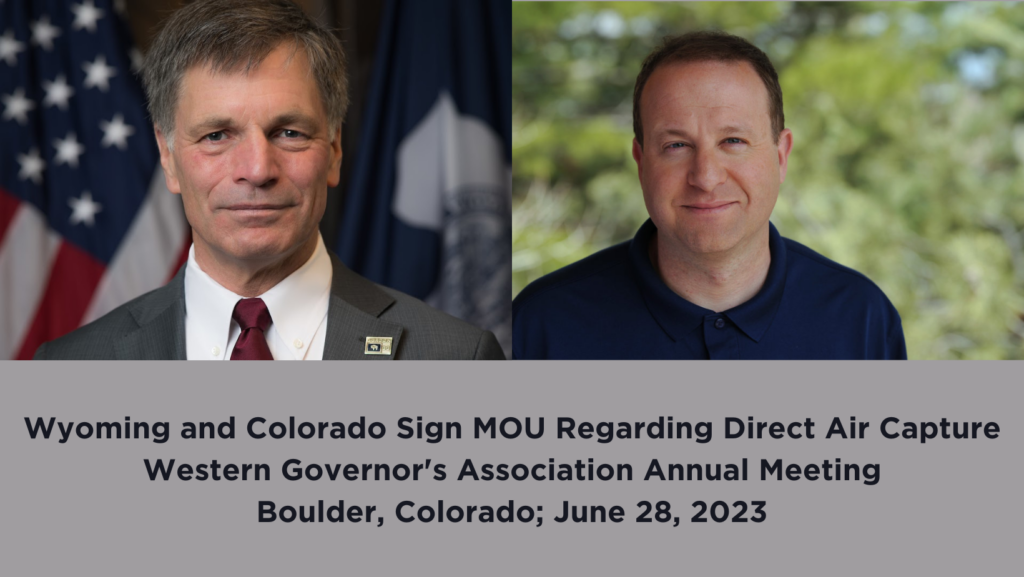
BOULDER, Colo. – The State of Wyoming and the State of Colorado announced today that they have signed a Memorandum of Understanding (MOU) regarding direct air capture (DAC) activity and development. The bipartisan inter-state agreement will focus on the DAC industry’s potential to complement existing and emerging industries and increase jobs and economic development in both states while simultaneously reducing carbon dioxide in the atmosphere. Governors Mark Gordon and Jared Polis announced the news during the Western Governor Association meeting today in Boulder, Colorado.
Direct Air Capture is a method of carbon dioxide removal (CDR) in which CO2 is removed from the air and then sequestered and stored to produce high-quality carbon removal credits or used for industrial applications, such as enhanced oil recovery or as a chemical feedstock for other products. The federal government has established several significant incentives and competitive grant opportunities to test and scale direct air capture technologies and projects. The mountain west is uniquely positioned to lead on these efforts, and this bipartisan agreement represents the first such multistate partnership in the county.
The MOU outlines the partnership between the states through potential collaborations such as: applying for grants, identifying necessary infrastructure, defining carbon removal measurement standards, analyzing atmospheric CDR markets and their growth opportunities, identifying a process for resolving issues with cross-border CO2 sequestration, developing a commercialization pipeline for nascent technologies, and ensuring that local, tribal, and state stakeholders are empowered participants in shaping the future of this innovative technology and its significant economic opportunity.
“Wyoming is a longtime leader in carbon management practices and policy,” said Wyoming Governor Mark Gordon. “We believe direct air capture could complement efforts for point-source carbon capture and the related infrastructure. Colorado and Wyoming each have pieces of the puzzle necessary to develop a carbon removal market and industry. Together, we have a powerful combination of assets, infrastructure, policy, markets, people, geology and mindsets that are needed to accelerate the development of the industry. This agreement focuses on working together on the most important questions related to DAC, including measurement standards that work to create more transparency in markets and benefits to communities.”
“This exciting bipartisan partnership builds upon our nation-leading work in Colorado to achieve 100% renewable energy by 2040 while adding good-paying jobs. I am proud to partner with Gov. Gordon on this innovative work that benefits both Colorado and Wyoming as we continue to find creative ideas and common-sense solutions in the fight for clean air that won’t just benefit Colorado and Wyoming, but the entire world,” said Colorado Governor Jared Polis.
The MOU highlights the combined assets, infrastructure, policy, markets, resources and geology that make the region a strong contender for developing a direct air capture industry. Wyoming has world-class carbon capture, use and sequestration (CCUS) assets, including permanent geologic storage – in addition to existing infrastructure, manufacturing and energy workforce. Colorado has been developing a policy environment to evaluate the regulatory, economic, technological, and research opportunities in the carbon dioxide removal and direct air capture area and is home to the world’s second-largest operating DAC facility.
This agreement builds on further regional collaboration between Wyoming and Colorado with Utah and New Mexico to develop the Western Interstates Hydrogen Hub. This existing partnership will mobilize billions of dollars of investment in clean hydrogen infrastructure, another emerging technology to reduce pollution and continue the West’s leadership on global energy solutions.
For more information, read the Memorandum in full.